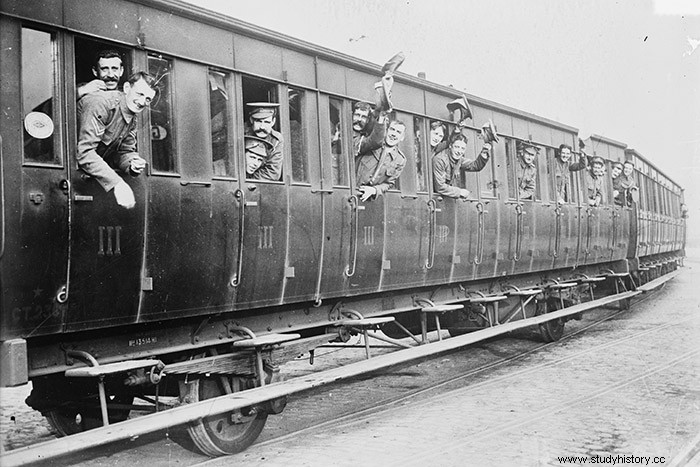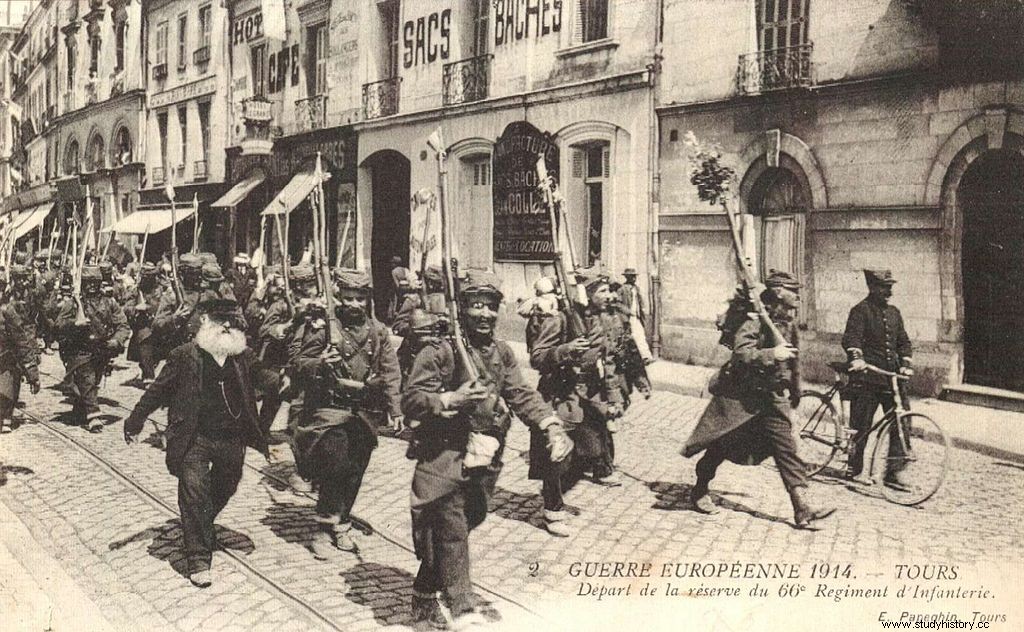"Leaving for the front". This is a subject that is little discussed in the writing of history on the First World War. If the fights are always very well described, the one-way trip to death, for many men, is not often studied. How do they reach eastern France, or the other different European fronts supported by France? But above all, in what state of mind do soldiers go to war? Are they so enthusiastic as the media of the time try to make public opinion believe? This is what we will try to understand. We have some routes in order to analyze how they go to the front.
Mobilization:going to war!

Saturday 1 st August 1914, general mobilization is applied throughout France. The country is entering a kind of military “state of emergency”. In all French municipalities, a poster kept at the town hall is posted in the public square or on the doors of the town hall:"General Mobilization". But war has not yet been declared. Some are hopeful that it will not be triggered; others know that this mobilization is in preparation for a conflict [1] .
If the first day of mobilization is decreed on Sunday August 2, some French people have already joined their regiment the day before, the day of the proclamation of the mobilization. This is the case, for example, of the rider Maurice Barret [2] , belonging to the 4 th Regiment of Cuirassiers, arrived on the 1 st August to the regiment. Others arrive even later, the 3 th August day, like Maurice Faure [3] , attached to the 1 st Depot of Fleet Crew, and probably far from his home at the time of mobilization, hence this delay authorized by the mobilization booklet that each Frenchman who can be mobilized has.
Soldiers of combat age, aged 21 to 48, are called to join their place of mobilization, which differs according to the residence of the individual. Once gathered, the regiments must then go to the station, the soldiers in military uniform, in overloaded wagons, leaving for the borders. They are then hundreds of thousands of men to join the east of France, knowing since August 3 that war is declared. As in 1870, France will have to fight the Germans once again.

Flower in the gun or tear in the eye?
The departure to the front experienced by the French men and women
During mobilization, the 1 st August 1914 and the following days, the state of mind is diverse and varied. We have long believed in the myth of the "flower with a rifle", the popular equivalent of the Sacred Union. However, since the 1960s, historical studies such as that of Jean-Jacques Becker have shown that the atmosphere was not as festive, and that patriotic impulses were more mixed. For example, we can distinguish the reactions of the towns, better informed thanks to the press, from those of the countryside. We see many patriotic outbursts in town very early on, and sometimes xenophobic violence against stores with German names, such as the Muller brasserie in Paris. In the countryside, on the other hand, the news is greeted with a certain amazement and a great deal of resignation.
The Minister of National Education at the time, Mr. Albert Sarraut, asked teachers to keep a diary on the state of mind of the French during the war. These logs are valuable sources. Thus in the Drôme, in Nyons, the teacher Mr. Roux testifies:“the population, although prepared for several days for war by the press, learned the unfortunate news with a kind of amazement. I saw a few women cry. The men looked sad, but determined [4] . It seems indeed that after the first reactions of stupefaction, a patriotic outburst took place, further reinforced by the feeling of defending his native land, the war having been declared by Germany. It was therefore, all in all, both surprised and resolute that the 1914 conscripts embarked for the front during the month of August.
The different classes mobilized in the following years were in a state of mind increasingly degraded by the length of the war, the privatizations in the rear and the information on life in the trenches. Thus some prefer to volunteer before the age of conscription, which allows them to choose their weapon; they prefer artillery or navy to infantry, whose mortality is much higher.
Gone to the front
A total of 3,780,000 French people were mobilized in a few days, and 8,410,000 throughout the war, including 7% from the colonies. If the material conditions of mobilization (assembly, then transport to the front) have not changed considerably during the four years of war, the state of mind of many French people, determined to defend their soil in 1914, gradually deteriorated. When the Armistice came on November 11, 1918, France was exhausted, and for a long time; which makes the historian Maurice Agulhon say that in the following years, France was "sick with the War".
Nord Departmental ArchivesGreat War MuseumThe call to war in Dauphiné
